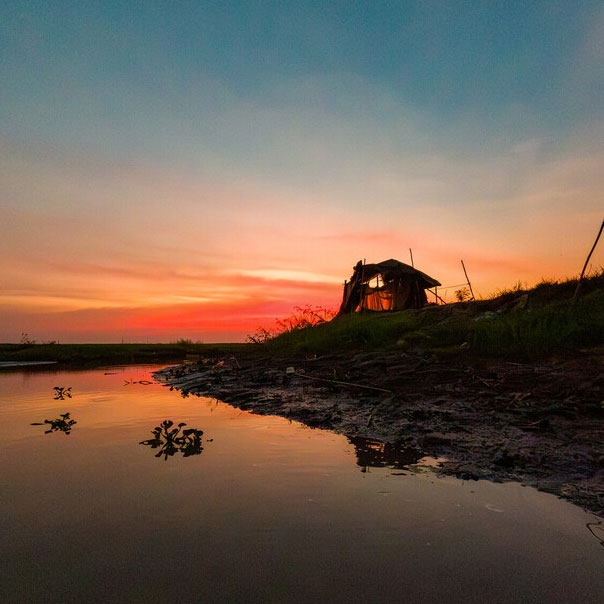Securing Cambodia’s Wetlands in the Lower Mekong
The Lower Mekong region in Cambodia is home to some of the world’s most important wetlands.
Cambodia is one of the world’s most wetland-dependent countries. Millions rely on the wetlands in the Lower Mekong for their survival, living off the rice and fish they provide and building homes on stilts and floats. These breath-taking wetlands are also home to some of the world’s rarest and most endangered species.
The challenge
But large areas of wetland are being destroyed to support Cambodia’s fast-growing economy with devastating effects on its people and wildlife. A third of the population no longer have access to clean water. The number of observed sarus cranes in Cambodia has dropped to less than 250.

Cambodia facts
- Freshwater wetlands cover more than 30% of the land area
- The population has grown from under 9M in 1990 to over 16M today
- Rapid annual GDP growth rate (6.9% last year), but unchecked development leading to collapse of wetlands and ecosystem services
- 90% of the 4.8 M impoverished Cambodian people live in rural areas with heavy reliance on ecosystem services
- Half of its seasonally flooded grasslands lost in ten years
What we are doing
Community based conservation
We’re working with farmers and fishers in two protected wetland areas – Boueng Prek Lapouv and Anlung Pring, so people can earn a stable income while at the same time protect the environment. We’re enabling communities to create associations to sustainably manage natural resources, which will support the livelihoods of more than 1,500 people.
We’re helping growers to produce climate-resilient crops that use less water and don’t need pesticides – so are better for wetlands - yet deliver better yields. Already local farming cooperatives are reporting improved profitability and a dramatic reduction in the use of chemicals.
Without the support from WWT, our wetlands would continue to be destroyed. Together we’ve developed a plan to give our children a future.
Van Tevy, WWT Local Community Apprentice
In Anlung Pring, we’ve helped set up a community led eco-tourism project which is now attracting hundreds of tourists who travel to the area to see the globally threatened sarus crane. Visitors can see flocks of up to 60 cranes in a true wildlife spectacle as they discover more about this magnificent bird and the local communities that live alongside it. They can learn how to make rice noodles, weave grass mats and even distil their own rice wine. The project is generating employment and bringing in thousands of dollars for local people and much needed money which is invested into more reserve management and community projects.
You can find out more about this project here: www.mekongcrane.com
Using our knowledge of biodiversity habitat, ecosystem services and livelihoods, we’re also working with communities and governments to agree core conservation areas, community sustainable use zones and habitat restoration areas.
Policy and advocacy
Working alongside local government and community groups, WWT is appraising regional development plans and attempting to embed wider water security issues into a more rigorous environmental impact assessment process.
We are helping regional environmental authorities to deliver conservation support to managers of Cambodia’s network of designated Ramsar sites.
We have also written a guidance plan for the sustainable management of Cambodia’s freshwater wetlands for wetland stakeholders in the region. It’s hoped this will improve understanding of:
- The importance of wetlands and the benefits they bring for people and wildlife
- What needs to be taken into account when managing wetlands
- Methods that can be used to improve the sustainable management of wetland features and activities
Wetland Management and Climate Change Resilience
We are also working to meet the wider challenges of water security faced in the Cambodian Lower Mekong Delta. The development of hydroelectric dams further up the Mekong River is altering seasonal water flows downstream in the sites where we work. In addition, in much of the delta, expanding irrigation systems are changing the hydrology of important sites such as Boeung Prek Lapouv. After the rainy season, water is now draining more quickly, meaning the area is now flooded for less time. Fish pools and nursery grounds, once available throughout the year, are now drying up by the end of the dry season. Native wet grasses – a vital food source for the sarus crane - are also struggling to survive because of the lack of water.

To create a better understanding of what is happening to water in the region, we are generating elevation maps and hydrological flow models for our sites to help identify suitable locations for water management trials and habitat restoration areas. We’re looking at ways to retain water for longer and assessing habitat responses to longer periods of inundation.
We are also conducting vulnerability assessments, including reviews of how communities have responded to extreme events in the past. This is helping us predict how climate change will affect Cambodia’s wetlands in the future, and helping us to design resilient conservation and sustainable livelihood programmes .
In addition, we’re conducting the first major assessment of the value and conservation status of remaining natural wetlands in the Cambodian Lower Mekong Delta.
Key achievements
- We created a community-based Ecotourism Centre at Anlung Pring Protected Landscape, attracting hundreds of tourists and generating additional income for local people and wetland conservation.
- We wrote a guidance plan for the sustainable management of Cambodia’s freshwater wetlands published for wetland stakeholders in the region.
- We delivered curriculum-linked environmental education schemes to over 500 local school children yearly.
- We supported environmentally sensitive management practices to improve livelihood security for over 350 farmers, fishers and harvesters of other natural resources.


